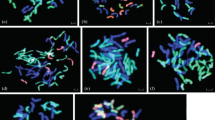Summary
F1 and F2 hybrids were produced using three winter wheat varieties (Bernina = biscuit wheat, Arina and Forno = bread wheat) and two spelt cultivars (Oberkulmer and Rouquin). Data are based on field trials in 1989 and 1990. All the combinations tested gave a very high relative heterosis on grain yield per ear, varying between 29.9% and 47.6% with an average of 42.1%. Even the higher parent was outyielded by 24.1% to 45.7%. This was the result of a heterosis effect on the two yield parameters grain number per ear and single grain weight. In the F2, heterosis for grain yield per ear was not significant with a range between 3.9% and 12.0%. F1 hybrids showed a heterosis effect on plant height but no hybrid was taller than the spelt parents. These data show that the gene pool of spelt could be potentially usefull for the selection of parents for hybrid production. For practical applications there remain several problems to be solved. Despite the very high heterosis effect the yield potential of spelt needs to be improved. No short spelt varieties exist at present to produce hybrids short enough for commercial application. Technical problems in the seed production arise because of the close tightness of the spelt glumes hampering either the pollination by the wheat parent or the pollen dispersal if used as a pollinator. However, a breeding effort to select for improved parents within the gene pool of spelt appears useful for future F1 hybrids between spelt and wheat.
Similar content being viewed by others
Abbreviations
- LSD:
-
Least significant difference
References
Bingham, J. & F.G.H. Lupton, 1987. Production of new varieties: an integrated research approach to plant breeding. In: F.G.H. Lupton (ed.), Wheat breeding its scientific basis. Chapman and Hall, London, New York: 487–533.
Bleiker, U. & H. Winzeler, 1991. A simple device to prepare single ears of spelt Triticum spelta for seeding with the ‘Seedmatic system’. Plant Breeding 106: 258–260.
Borghi, B. & M. Perenzin, 1990. Yield and yield stability of conventional varieties of F1 bread wheat varieties. J. Genet. & Breed. 44: 307–310.
Borghi, B., M. Perenzin & R.J. Nash, 1988. Agronomic and qualitative characteristics of ten bread wheat hybrids produced using a chemical hybridising agent. Euphytica 39: 185–194.
Borghi, B., M. Perenzin & R.J. Nash, 1989. Combining ability estimates in bread wheat and performance of 100 F1 hybrids produced using a chemical hybridising agent. J. Genet. & Breed. 43: 11–16.
Brears, T., A.G. Hydon & J. Bingham, 1988. An assessment of the feasibility of producing F1 and F2 hybrids for the U.K. In: T.E. Miller & R.N.D. Koebner (Eds), Proceedings of the 7th International Wheat Genetics Symposium. Institute of Plant Science Research, Cambridge Laboratory, Trumpington, Cambridge: 1157–1162.
Keydel, F., 1973. Untersuchungen über die Leistungseigenschaften von F1 Hybriden von Winterweizen. Zeitschr. Pflanzenzüchtung 69: 239–255.
Liu, Y.G., N.M. Mori & K. Tsunewaki, 1990. Restriction fragment length polymorphism (RFLP) analysis in wheat. I. Genomic DNA library construction and RFLP analysis in common wheat. Jpn. J. Genet. 65: 367–380.
Mariani, C., V. Gossele, M. De Beuckeleer, M. De Block, R.B. Goldberg, W. De Geef & J. Leemans, 1992. A chimaeric ribonuclease-inhibitor gene restores fertility to male sterile plants. Nature 357: 384–387.
Morgan, C.L., R.B. Austin, M.A. Ford, J. Bingham, W.J. Angus & S. Chowdhury, 1989. An evaluation of F1 hybrid winter wheat genotypes produced using a chemical hybridising agent. J. Agric. Sci., Camb. 112: 143–149.
Perenzin, M., M. Corbellini & B. Borghi, 1987. Growth analysis of ten bread wheat hybrids (Triticum aestivum) produced with a chemical hybridizing agent. Genet. Agr. 41: 163–172.
Pickett, A.A., 1993. Hybrid wheat-results and problems. Advances in Plant Breeding 15, pp. 259. Paul Parey Scientific Publishers.
Rüegger, A., H. Winzeler & J. Nösberger, 1990a. Untersuchungen über das Keimungsverhalten von Dinkel (Triticum spelta L.) und Weizen (Triticum aestivum L.) unter erschwerten Bedingungen. Seed Science and Technology 18: 311–320
Rüegger, A., H. Winzeler & J. Nösberger, 1990b. Die Ertragsbildung von Dinkel (Triticum spelta L.) und Weizen (Triticum aestivum L.) unter verschiedenen Umweltbedingungen im Freiland. J. Agr. Crop Sci. 164: 145–152.
Rüegger, A. & H. Winzeler, 1993. Performance of spelt (Triticum spelta L.) and wheat (Triticum aestivum L.) at two different seeding rates and nitrogen levels under contrasting environmental conditions. J. Agr. Crop Sci. 170: 289–295.
Schmid, J.E. & H. Winzeler, 1990. Genetic studies of crosses between common wheat (Triticum aestivum L.) and spelt (Triticum spelta L.). J. Genet. & Breed. 44: 75–80.
Schmid, J.E., H. Winzeler, B. Büter & P. Stamp, 1991. Vergleichende Untersuchungen zur Erzeugung von Doppelhaploidenbei Weizen und Mais. Bericht über die Arbeitstagung der Arbeitsgemeinschaft der Saatzuchtleiter in Gumpenstein, 26–28. Nov. 1991: 55–63.
Schmid, J.E., M. Winzeler & H. Winzeler, 1994. Analysis of disease resistance and quality characters of F1 hybrids of crosses between wheat (Triticum aestivum) and spelt (Triticum spelta). Euphytica, submitted.
Weeks, J.T., O.D. Anderson & A.E. Blechl, 1993. Rapid production of multiple independent lines of fertile transgenic wheat (Triticum aestivum). Plant Physiol. 102: 1077–1084.
Winzeler, H. & A. Rüegger, 1990. Dinkel: Renaissance einer alten Getreideart. Landw. Schweiz 3 (9): 503–511.
Winzeler, H. & J. Schmid, 1983. Neue Wege der züchterischen bearbeitung einer alten Getreideart — am Beispiel des Dinkels. Bericht über die Arbeitstagung der Arbeitsgemeinschaft der Saatzuchtleiter in Gumpenstein, 22–24. Nov. 1983: 109–124.
Winzeler, H., M. Winzeler & J.E. Schmidt, 1991. Vererbung verschiedener Merkmale von Dinkel (Triticum spelta L.) und Weizen (Triticum aestivum L.) Landw. Schweiz 4 (8): 443–447.
Author information
Authors and Affiliations
Rights and permissions
About this article
Cite this article
Winzeler, H., Schmid, J.E. & Winzeler, M. Analysis of the yield potential and yield components of F1 and F2 hybrids of crosses between wheat (Triticum aestivum L.) and spelt (Triticum spelta L.). Euphytica 74, 211–218 (1993). https://doi.org/10.1007/BF00040403
Received:
Accepted:
Issue Date:
DOI: https://doi.org/10.1007/BF00040403



